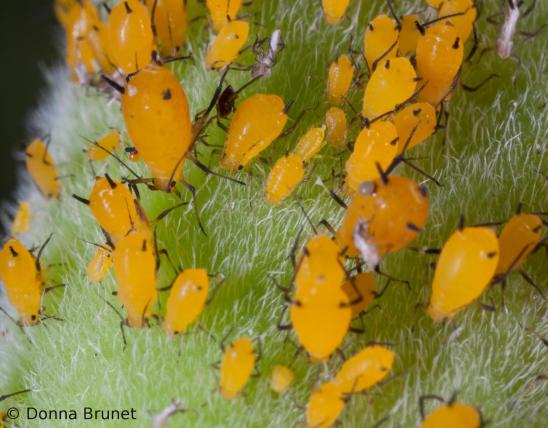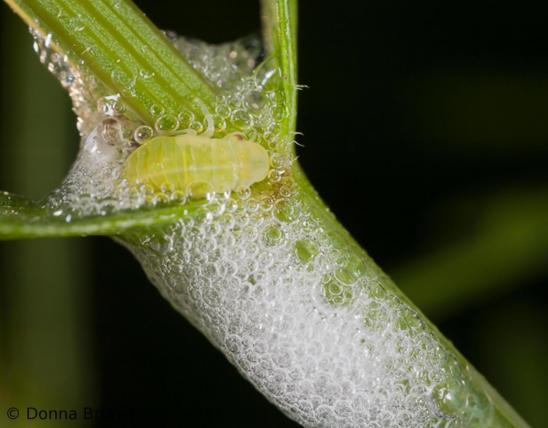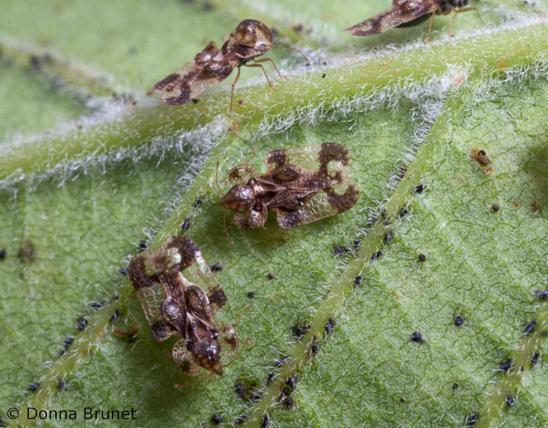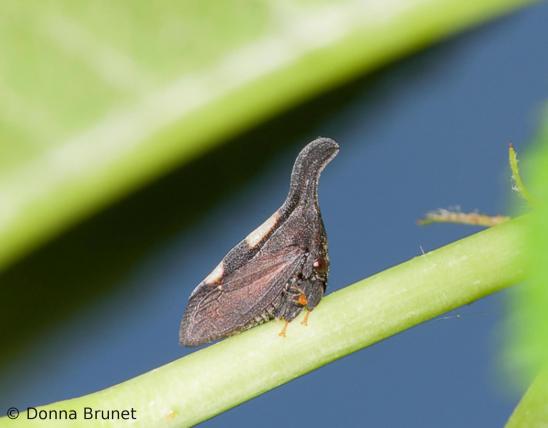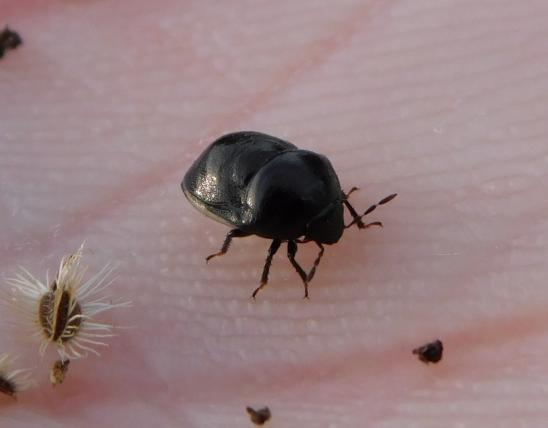
Hackberry psyllids (pron. SILL-ids) are a genus of tiny, planthopper-like bugs. As larvae, they develop within the leaves, twigs, buds, or bark of hackberry trees. The trees form warty galls in response to their presence. In the fall, tiny adult hackberry psyllids cling to window screens. If you look closely, you’ll see they look a lot like tiny brownish cicadas. Most have brown-and-white mottled or spotted wings, while at least one species has solid brown wings. They can walk but they can also jump.
Scientists aren’t sure how many species of hackberry psyllids there are in North America north of Mexico. Estimates range from 7 to 13 species.
One commonly encountered group — whose members form galls on hackberry leaves, as opposed to leaf stems, buds, twigs, or bark — may include four to seven different species that have traditionally all been considered the single species P. celtidismamma. Looking at their bodies, there is no discernible difference among them, but they produce galls with different shapes: some are like rounded cones or disks, some are like indented mushroom caps, some are like pudgy doughnuts, some are knobby like nipples; and the nipple galls may be hairy or glabrous (smooth). One type makes inflated, blister-like pouches within the leaf. Genetic testing will probably sort out these various species.
Similar species: In North America north of Mexico, there are nearly 80 species in the family Aphalarida. Globally, there are eight families of insects in superfamily Psylloidea, and all are usually called psyllids or jumping plant lice. Expanding outward to less closely related groups, psyllids are in the same suborder as aphids, scale insects, mealybugs, whiteflies, and the phylloxera insects (you may have heard of the notorious grape phylloxera that threatened the global wine industry in the late 1800s and remains a serious pest of grapevines).
Length: less than ¼ inch (2–6 mm); varies with species.
Statewide.
Habitat and Conservation
Hackberry psyllids occur anywhere there are hackberry trees, which means they can occur nearly anywhere in our state. Most people notice them — the big knobby galls, and the adult psyllids clinging to window screens — in late summer and fall.
Psyllid numbers may fluctuate in different years. For species that lay eggs in buds and leaves, the timing of egg-laying is critical. If the female doesn’t deposit eggs at the correct time in the leaves’ development, the galls may not form properly and the larvae fail to develop.
Food
Hackberry psyllids suck the juices of hackberry trees. Most of the feeding occurs when the psyllids are in their juvenile form.
Missouri has three species of hackberries. Our most widespread and familiar hackberry is the common hackberry (Celtis occidentalis), which can grow statewide in any moist, fertile area. We also have sugarberry (C. laevigata), which is more common in bottomlands and is mostly absent from the northern third of Missouri, and dwarf hackberry (C. tenuifolia), which prefers rocky, open woods, glades, and bluffs; it, too, is mostly absent from Missouri’s northern third, and also from the Bootheel.
Status
Hackberry galls look weird on hackberry leaves and twigs, but they usually don’t hurt the tree. Hackberry trees are not commonly cultivated and are not highly valued commercially by most people.
Hackberry psyllids are completely harmless to people.
Life Cycle
Eggs hatch and become larvae (nymphs). The nymphs suck the juices from the leaves or other parts of the hackberry, and the tree responds by forming a distinctively shaped gall around the feeding insects. Nymphs are rarely seen, since they live mostly inside the plants they are eating. Carefully cut open a gall, and you may discover one of the nymphs inside it.
There are 5 nymphal stages. In late summer or early fall, the insects emerge from the galls and become sexually mature, winged adults. The adults will overwinter in a protected place. In spring, the females deposit eggs on hackberry leaves or other appropriate parts of the plant, depending on the species. For the species that form leaf galls, the leaves are suitable for egg-laying only during a brief stage in the leaves’ development in spring.
Human Connections
Sometimes the adult psyllids can be very numerous in window screens in late summer or fall. It might be annoying, but these insects are completely harmless to people.
The genus name, Pachypsylla, comes from the Greek pachy- (thick) and psylla (a flea). The entomologist who created the name for this genus was Charles Valentine Riley, born in England, who immigrated to America and became Missouri’s first state entomologist before moving on to top entomological appointments at the USDA and Smithsonian Institution. He spent much of his career studying insects that were important as agricultural pests, and he pioneered the study of using predatory insects as biocontrols on pest species. A brilliant and prolific scientist, he died at a vibrant age 52 as the result of a bicycle accident.
Ecosystem Connections
Hackberry galls look weird on hackberry leaves and twigs, but they usually don’t hurt the tree.
Small insects, such as these psyllids, are eaten by larger insects, spiders, and other relatively small predators. The larger insects are consumed by larger predators such as songbirds (especially during nesting season), lizards, toads, and more. Insects are a critical part of the ecosystem, converting plant materials into a form that can be consumed by other animals.






























